| |
|
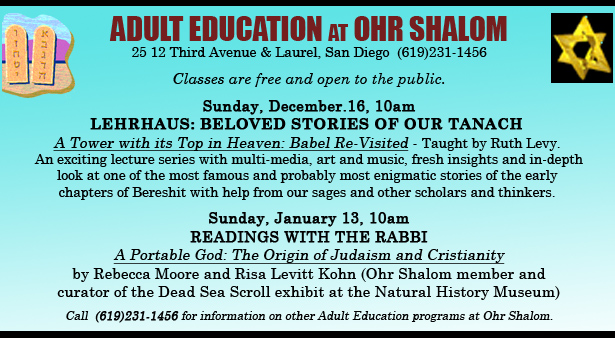
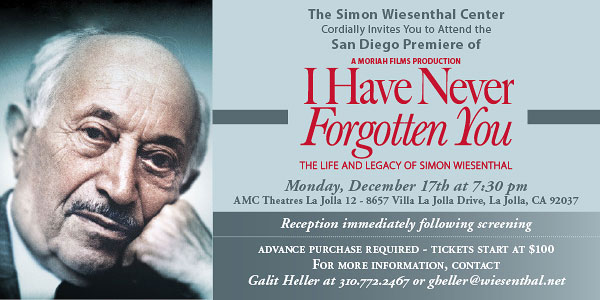
LETTER FROM JERUSALEM
'Apologies' as presidential campaign tactics
By Ira Sharkansky
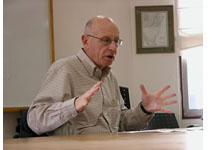 JERUSALEM—Among the lessons in practical politics from the run-up to the Iowa caucuses are two examples on how to besmirch your major rival, while verging over the borders of the political correct, then apologize, and get your besmirching even more attention on national and state-wide media. JERUSALEM—Among the lessons in practical politics from the run-up to the Iowa caucuses are two examples on how to besmirch your major rival, while verging over the borders of the political correct, then apologize, and get your besmirching even more attention on national and state-wide media.
A key aide of Hillary Clinton got some space in the Washington Post, and then more widely, when he asked if it would not be likely that
Ira Sharkansky
someone will ask questions about Barak Obama's youthful experimentation with drugs, and perhaps givE drugs to friends, or maybe even sell them.
A day later, the aide resigned, Hillary apologized and disowned the comments, but there they were again in the media. Insofar as the wife of the dishonored aide is the former Governor of New Hampshire and a candidate for the U.S. Senate, and the Obama-Clinton competition will have another round in that state, it is fair to assume that we have not heard the last of this.
Lesson two comes from Mike Huckabee. When asked about Mitt Romney's Mormonism, he wondered if it was not true that Mormons believe that the devil and Jesus were brothers.
One does not have to be an expert on Evangelical theology to know that Satan is a major negative in their world view.
It did not take long for Huckabee to apologize to Romney for what he said was an innocent question, and not an effort to raise Romney's religion as a campaign issue. If there are some Evangelicals in Iowa who did not get the message the first time, they may get it now, along with Huckabee's assertion of being a good guy without any Satanic agenda.
When I lectured on this topic at the dinner table, Mattan responded with yet another indication of his decent Israeli education. He recommendation that I take a look at the first passages in the Book of Job. The literal translation is:
Now it fell upon a day, that the sons of God came to present themselves before the Lord, and Satan came also among them. (1:6)
Does this mean that Satan was one of God's sons (and by Christian implication a brother of Jesus), or something else, perhaps an interloper among the sons of God. Some Christian translations emphasize a distinction between God's sons and Satan (According to the Contemporary English version, the passage is: "One day, when the angels had gathered around the LORD, and Satan was there with them"), but that adds something not in the Hebrew.
Some may claim that the Hebrew "Satan" is not the devil, but "the accuser," but that opens the door to complexities that are not apparent from a simple reading of the Hebrew text (השטן ).
Assuming that Evangelicals are serious in accepting the Bible as true, it would appear that they, as well as the Mormons, must reckon with the membership of God's family.
However, anyone who has read a bit about religion should not be surprised if the Evangelicals and others have their own ways of reading this passage, or simply ignore it. The faithful in different communities concede that the Bible's meaning is not always clear, and that it is important to choose an appropriate teacher.
What may be most important in all of this, including the apologies, is that voters in Iowa have been given reason to think that Barak Obama was a drug dealer, and that Mitt Romney worships the devil.

AMAZING STORIES OF JUDAISM
The boy hockey player and the seniors
By Rabbi Baruch Lederman
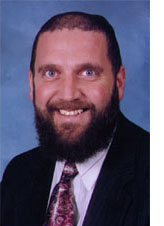 SAN DIEGO—Engaging in Gemilas Chesed (acts of loving kindness), affects you in ways you may not have been able to fathom, as the following story from Alan Radding, illustrates: SAN DIEGO—Engaging in Gemilas Chesed (acts of loving kindness), affects you in ways you may not have been able to fathom, as the following story from Alan Radding, illustrates:
Marty knew he should be thinking about his father and his family, but all he could think about were himself and hockey camp. His father had been hurt last summer in an accident and hadn't been able to work since then. He could barely move around the house, and then only with the help of crutches. Marty's mom worked hard, but she couldn't make enough money for the family all by herself. Hockey camp was out of the question now. It was too expensive, Marty's mom told him. It was all so unfair.
Marty was 10 years old, and loved sports, all sports. He was especially good
Rabbi Baruch Lederman
at hockey, which his dad had taught him. He loved hockey and worked hard at it. He finally qualified
for a special summer hockey camp taught by real NHL hockey stars. Now, he wouldn't be able to go. "I know how important it is to you, but we just don't have the money, darling," his mom had told him.
If he could only get a job after school, Marty thought. He would earn money and pay for hockey camp himself, but he knew that was just dreaming. Who would hire a ten-year old? How much could he make? For hockey camp, he needed over $1.000—more money than he could imagine earning.
Marty's father had the chance for some special rehabilitation, but he would have to go to a hospital in a different city. His parents didn't think they could afford it.
As he walked into Hebrew school, Marty was thinking about buying a lottery ticket and winning millions of dollars like he'd seen people do on TV. Of course, he knew that he was too young to buy a lottery ticket. The people at the synagogue had been nice, bringing meals over and driving his dad to therapy sessions, but they couldn't do anything about hockey camp. That would take a miracle, and Marty didn't think miracles happened anymore.
Marty told the rabbi about hockey camp and how things were getting really bad for the family. "Thanks for telling me, Marty. I hadn't heard these latest developments. Maybe there is something I can do to help," he said.
"About hockey camp?" Marty asked hopefully.
"I wasn't thinking of hockey camp exactly, but you never know," the rabbi replied.
Marty didn't hold out much hope for help from the rabbi - his mother and father were dead set against accepting charity. But he couldn't stop thinking about hockey camp. A few days later, the rabbi called Marty into his office. Maybe he had found a way for him to go to hockey camp. For the first time in a week, his hopes rose.
"One of our older members is living in a nearby nursing home," the Rabbi explained. "His family lives far from here and would like someone to visit him a few days a week, maybe read the newspaper to him and push him around in his wheelchair. It won't be for very long, just until they get him transferred to a place near where they live." Marty showed no hint of interest. "It would really be a mitzvah, gemilas chesed, an act of loving kindness," the rabbi concluded.
Marty was terribly disappointed. This was the last thing he wanted. It was enough having to deal with his father, who hobbled around the house on crutches. Now he would have to help some old guy he didn't even know.
"Sometimes when we ourselves need help the most, G-d offers us an opportunity to help others," the rabbi quickly went on, as if reading Marty's mind. "By doing mitzvos, we make the world better for ourselves too." Marty didn't care much about the world lately and certainly didn't want to visit some old guy, but he told the rabbi that he would talk about it with his mother.
At home that evening, Marty's mother insisted that he do it. The community had been so kind to them in their time of need how could he not help, she reasoned.
The rabbi came with Marty to the nursing home the first day and introduced him to Mr. Greenblatt. Mr. Greenblatt was sitting in a wheelchair. He could no longer see or walk, but he sounded cheery. "Call me Fred," he told Marty.
It turned out to be an easy job. Marty would stop by after school two days a week. He would wheel Fred to the day room, a lounge where a bunch of other old guys sat around. Then, he would read stories from the newspaper's sports section. Marty loved sports, so he was glad to read sports stories. Fred seemed to know a lot about sports. The other old guys often came overand listened. Before long they would be talking and arguing about teams and players. Marty would sit back and listen.
Once they were discussing basketball. One of today's star players had punched and kicked his coach. The old guys complained that players were too rich and too disrespectful. "If I did something like that when I was playing ball, they would have booted me off the team and out of the league immediately," said Fred.
"You played basketball? For a professional team?" asked Marty, incredulous.
"Ain't you ever heard of Fred Green? He used the name Green, not Greenblatt, back then," said one of the old guys.
Fred, it turned out, had been a professional basketball player. He gave it up to have a family and live a Jewish life. "It wasn't the kind of money that it is today, and I never liked all the traveling and having to play on Friday night and Saturday. I've always enjoyed Shabbos," Fred told Marty.
Marty couldn't believe he had been talking sports with a real basketball player. Over the next few weeks, Fred gladly answered Marty's eager questions. He also asked Marty about his own interest in sports. Marty told him about hockey and hockey camp and his dad. "You seem like you'd be good at hockey. Maybe things will work out for you," Fred said, "but there are more important things than playing sports."
In the visits that followed, Marty still read the sports news and they talked about sports, but they also talked about other things, like family. "The love of your family is the most important thing," Fred said often.
One day, Marty arrived to find Fred very excited. "I'm moving to be near my children next week," he reported. Marty was happy for Fred, but sad too. He had come to look forward to his visits with Fred and the other old guys. In the day room, the others were sad. Marty realized that they also would miss Fred.
Suddenly, one of the old guys turned to Marty, "I guess we won't be seeing you any more, young feller. We'll really miss you," he said. Marty, to his surprise, found himself too choked up to even reply. He walked around and hugged each of them.
A few weeks later the rabbi stopped by Marty's house. "The Greenblatt family is very thankful for the friendship and attention you gave Mr. Greenblatt. It was a wonderful mitzvah," the rabbi said. "They wanted me to give you this," he added, holding an envelope in his hand.
Marty couldn't believe it when he opened the envelope. It held a check for more money than Marty could have hoped. "But they don't owe me anything," he stammered. The money, the rabbi explained, was a gift, a gesture of their appreciation.
"I'll guess I'll be packing you off to hockey camp," said his mother. She caught Marty by surprise. He had given up thinking about hockey camp. After the weeks with Fred and the other old guys, he had sort of forgotten about hockey camp. He still loved hockey, but it just didn't seem like such a big deal any more.
He took the check and handed it to his dad, "I want you to go to that special hospital and get better," Marty said. "Then maybe you can send me to hockey camp next year."
The old guys were stunned when Marty strolled into the day room the next week at his usual time. "Anybody want me to read the sports news?" he announced. The old guys rushed over to him. For the first time since his dad got hurt, Marty felt really good.

Jewish Travel
Portugal: pleasant surprises for Jews
By Dov Burt Levy
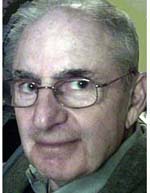 LISBON—The government of Portugal wants you to visit their country. Not just us Americans, but American Jews in particular. That's why I, along with four travel writers, was invited to spend a week in Portugal last spring, visiting places of interest to Jewish tourists. No, they are not making amends for the Jewish expulsion in 1496 but rather Portugal, like Spain and other countries, see the Jewish community as an important niche tourist market, in a world where tourism brings in money. LISBON—The government of Portugal wants you to visit their country. Not just us Americans, but American Jews in particular. That's why I, along with four travel writers, was invited to spend a week in Portugal last spring, visiting places of interest to Jewish tourists. No, they are not making amends for the Jewish expulsion in 1496 but rather Portugal, like Spain and other countries, see the Jewish community as an important niche tourist market, in a world where tourism brings in money.
I came, I saw, I write. In between, I ate in excellent restaurants, lodged at interesting and even luxurious places, like mountaintop ancient castles, monasteries and convents, called pousadas. We even visited two enterprises the government is proud of: one is a winery producing
Dov Burt Levy
kosher wines; and the other is a fine olive oil manufacturer producing a kosher product.
First stop, Lisbon, which is a large, attractive European capitol.
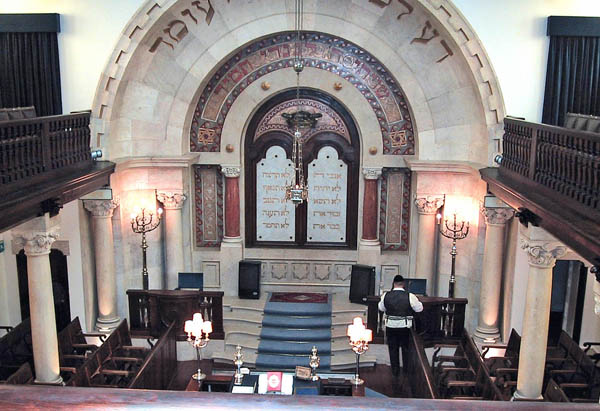
The largest Lisbon synagogue is Sinagoga Shaaré Tikvá, a structure opened in 1904, after 50 years of work by returning Jews following the official end of the Inquisition in 1854. Shaaré Tikvá serves the estimated 300 Jews now living in and around Lisbon, with 600 Jews in the entire country. A synagogue member gave our group a brief history of the synagogue and of the Jews in Portugal.
The story begins in Spain in 1492, when Jews were ordered to convert to Catholicism or leave the country. Christians had regained control of the country after 200 years of Muslim rule. Thousands (tens of thousands?) of Jews crossed the border to Portugal, paid a steep immigration tax, and settled there or made their way to other lands.
Another case of Jewish bad luck. Four years later, the Portuguese king, desirous of arranging a marriage between his son and the Spanish princess, agreed as part of the deal to expel the Jews from Portugal. The order was given again: convert or leave.
In less than a year, the Portuguese king found that among the Jews who were leaving were many he'd rather keep — physicians, merchants and others. So he gathered all the remaining Jews into Lisbon, declared the borders closed and announced that a mass conversion to Catholicism would follow.
Our speaker spread her arms to shoulder height, as the archbishop might have done, and said, "Poof, poof. You are all Christians."
The Jews got the name "New Christians," a handy way to identify the former Jews.
How many Jews, what percentage of the population they were, are interesting questions to which I found no answers.
But we do know that a large number of Jews decided to secretly maintain their Jewish customs at home while attending the obligatory Sunday masses. They did so at great risk, because Crusaders came by periodically to find and burn at the stake people considered not Catholic enough.
Fast-forward to 1917 when a Polish-Jewish mining engineer named Samuel Schwarz stumbled upon hidden Jews in the city of Belmonte and wrote a monograph about them. In the 1960s, with the establishment of Israel and the movement to find long-lost Jews, about half of the hidden Jews, often called 'Converso", in the community of Belmonte were officially converted to Judaism and a modern synagogue was built.
Luckily for me, our group went to Belmonte on a Saturday morning and at 11 a.m. I found myself outside the new, modern synagogue. I donned my Israeli kippa, walked in and was given a seat.
Congregants filled about 20 percent of the 80 men seats downstairs and about the same amount of women on the second floor. The older men were mostly dressed in dark blue suits, white shirts, like Shabbat worshippers all over the world. A few younger men wore clean pressed jeans.
Sitting there, I had time to think about this amazing story, that these people maintained both enough memory and ritual to re-embrace Judaism 500 years, 20 generations, after being forced into a façade of Christianity. I also thought about Portugal being one of the few European countries during World War II that provided a short term safe haven and a sailing point to other countries for Jews caught in the Holocaust. The irony of history.
Now, the big question is: does the country have enough interesting Jewish destinations to justify a visit if rediscovering Portugal's Jewish history and culture is your main objective?
The answer is yes, there are plenty of places to visit and enjoy, both Jewish and otherwise. If Jewish history and artifacts are your major interest, your best bet would be to arrange a tour with an American Jewish institution, either religious or educational, that would include an on-tour, on-site scholar to guide you. The local Portuguese tour guides try hard but just don't have enough knowledge of the Jewish saga.
A pre-trip minimum would be a good look at the Jewish Virtual Library and search for Portugal.
An eight-day "Jewish Heritage in Portugal" tour for the independent traveler is also offered by Alta Tours of San Francisco , which will arrange hotels and cities, but you will have to do lots of study in advance. I know nothing more about it than their free brochure. Other companies doing Jewish Portugal tours may be found by searching "Jewish travel Portugal" and "Jewish tours Portugal" on Google.
Don't do anything before contacting the Portuguese Government Tourist office, ICEP, 500 Fifth Avenue, NY 10036-1785 212-719-3985, and requesting their Jewish materials, particularly the free 68-page brochure "Journey to Jewish Portugal."
This was my second trip to Portugal (the first in 1955) and I can agree with Mark Harding, editor of Portugal Travel Guide, "The first thing travelers normally notice is how intriguingly different Portugal is from Spain, such as the language, food, history and music. And then they realize how pleasant the people are, for they seem to have unlimited patience when dealing with tourists."
That alone, dear reader, is a big plus for every tourist.
Also, you have the opportunity to combine the trip to Portugal with a trip to Israel. It is only a five-hour flight from Lisbon on Iberia Airlines, which offers a code share with El Al. Take half the trip in Portugal, half in Israel. You'll love it.
Some locations of Jewish Portugal
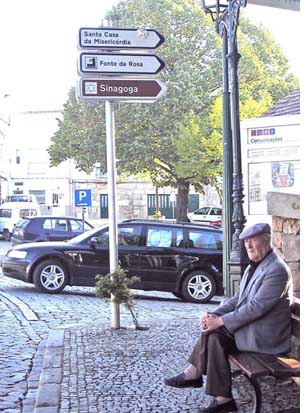 Lisbon: Alfama quarter is where large numbers of Jews settled in the 15th century. The Rue du Judiaria and Beco das Barrelas are two streets worth visiting. At #8 Beco, is the site of an ancient synagogue. Today's active synagogue, Shaaré Tikvá, 59 Rua Alexandre Herculano is in the city center. The City Museum (Museu du Cidade) contains a series of engravings on the Inquisition including heretics being burned at the stake (autos-da-fe). Lisbon: Alfama quarter is where large numbers of Jews settled in the 15th century. The Rue du Judiaria and Beco das Barrelas are two streets worth visiting. At #8 Beco, is the site of an ancient synagogue. Today's active synagogue, Shaaré Tikvá, 59 Rua Alexandre Herculano is in the city center. The City Museum (Museu du Cidade) contains a series of engravings on the Inquisition including heretics being burned at the stake (autos-da-fe).
Porto: Synagogue, "Mekor Haim" (Fountain of Life) built in 1929.
Tomar: The Jewish quarter consisted of one street, Rua Dr. Joaquim Jacinto, in the 14th century. At #73 is the synagogue used until 1496 and classified as a World Heritage site by UNESCO.
Belmonte: The largest nucleus of conversos were found here in the 20th century, half of whom reconverted officially to Judaism. Belmonte is where the beautiful "Bet Eliahu" synagogue was build.
Evora: In the 15th century had one of the largest Jewish quarters in Portugal. Close by is Alpalhao, a small town where mezuzot can be seen attached to the door posts of some medieval houses in the old Jewish quarter

THE JEWISH CITIZEN
SDJA Student Quarterly makes its debut
By Donald H. Harrison
 SAN DIEGO—It was something of a historic day at San Diego Jewish Academy on Friday, at least for contributors to Volume 1, Number 1, of the SDJA Student Quarterly, a newspaper that made its debut under the editorship of Alexa Katz, a high school junior. SAN DIEGO—It was something of a historic day at San Diego Jewish Academy on Friday, at least for contributors to Volume 1, Number 1, of the SDJA Student Quarterly, a newspaper that made its debut under the editorship of Alexa Katz, a high school junior.
The eight-page tabloid drew upon the talents of students in the digital photography, graphics arts, and journalism classes taught respectively by Dustin Wood, Doug Kipperman and myself. Additionally, a number of
Donald H. Harrison
volunteers contributed their stories and art work to the newspaper which focuses on activities at SDJA’s Maimonides Upper School but which also follows students in their activities off campus.
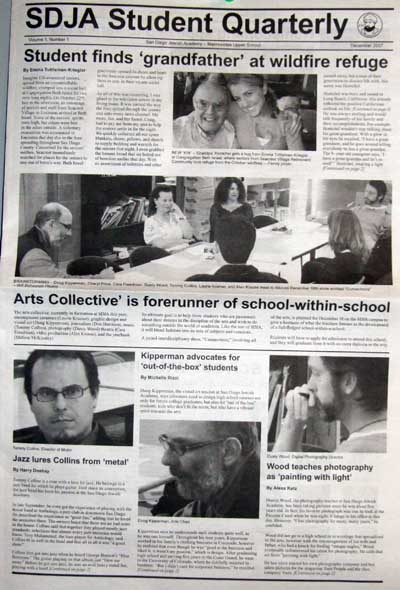 There was some disappointment that a wonderful story by Emma Tuttleman-Kriegler, which had been displayed at the top of Page-1, had some jumbled type, so that there was a gap in her recounting of her experiences while volunteering to help seniors from Seacrest Village Retirement Community. The seniors had been forced by the October wildfires to evacuate to temporary shelter at Congregation Beth Israel. I quoted to the students an old saying in journalism: “Doctors bury their mistakes; we publish ours.” They laughed, but I know that they wished that the premier issue could have turned out absolutely perfectly. There was some disappointment that a wonderful story by Emma Tuttleman-Kriegler, which had been displayed at the top of Page-1, had some jumbled type, so that there was a gap in her recounting of her experiences while volunteering to help seniors from Seacrest Village Retirement Community. The seniors had been forced by the October wildfires to evacuate to temporary shelter at Congregation Beth Israel. I quoted to the students an old saying in journalism: “Doctors bury their mistakes; we publish ours.” They laughed, but I know that they wished that the premier issue could have turned out absolutely perfectly.
From the standpoint of the students’ efforts and enthusiasm, I thought that the paper in fact did turn out perfectly. Besides Emma’s story (which we republish in corrected form below), there were bylined articles on such diverse subjects as homecoming festivities, applying for college, same-sex marriages, a rogue gossip website that roiled students, a Muslim cleric explaining Islam to a campus audience, a physics experiment involving dropping pumpkins from a crane; the cancellation of the women’s tennis season, and two student rowers who have competed in tournaments around the world. There were also briefs on a variety of other topics.
There even was a bit of “muckraking” in the first newspaper—an article by Eitan Frysch in which high school principal Jeff Davis and the head of the kitchen staff, Edward Blumberg, were asked why the quality of cafeteria food seems to have deteriorated. The two men differed as to the cause, but both promised improvements.
On the masthead of the newspaper is a drawing of Moses Maimonides on a 25-cent piece—what better symbol for a “quarterly” at the Maimonides Upper School? The back page, on which commentary is printed, fittingly is called “The Guide for the Perplexed” after one of Maimonides’ most famous works.
On that page were two essays which dramatically illustrate what wonderful neshumas some SDJA students have. Charly Jaffe wrote a story suggesting that when SDJA students feel stress over tests, or college applications, or the other normal problems of high school life, they should consider the situation of students at their sister high school in Sha’ar Hanegev, the region of Israel next to the Gaza Strip. Students there not only have similar academic concerns but also worry whether missiles fired by Hamas on a regular basis will drop on their school.
In another essay, Gaby Maio described the life of a mother with two young children who is trying to cope while her husband, a sailor, is serving in the Middle East. “I realized that it is up to us—the uninvolved—to help these families who are fighting our nation’s war for us,” she wrote.
The brand new newspaper also had lighter articles. Wood authored an advice column responding to questions concocted by the journalism students on body images and school prayer sessions. Harry Doshay, editor of the arts section, debated Michelle Rizzi, the newspaper’s managing editor, in a pro-con presentation on the movie Across the Universe. Michelle gave the Beatles-inspired movie a thumb up; Harry turned his thumb down. Daniel Penner offered mixed reviews of a Neil Young concert and a Serj Tankian album, and Katz provided a generally favorable critique of the film Music Within, which deals with the subject of people with disabilities.
Photo editor Will Bohannon selected from a wide variety of photos for a two-page center spread illustrating a day in the life of San Diego Jewish Academy, utilizing the works of Maio, Zuri Michan, Ilan Bielas, Stan Kaplan, Asher Wittenberg, Lokesh Bellam, and Rachel Breslauer.
A drawing, an illustration and a cartoon strip by Molly Laurie-Roberson, and behind the scenes copy editing by Dana Newfield, rounded out the remarkable student contributions to the inaugural edition.
Katz, in her signed column as editor-in-chief, wrote: “This is, after all, a student paper, and the newspaper staff wants to represent the students of the Academy the best we possibly can.”
Being the journalism teacher, I am of course a bit biased on the subject. I declare unhesitatingly that the staff of SDJA Student Quarterly accomplished that goal admirably.
Harrison is editor and publisher of San Diego Jewish World
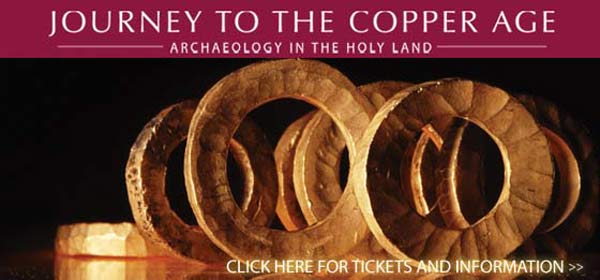

SDJA STUDENT QUARTERLY
Student finds 'grandpa' at wildfire refuge
Editor's Note: The following story by San Diego Jewish Academy student Emma Tuttleman-Krieglerinitially appeared in the inaugural issue of SDJA Student Quarterly discussed above in the column by Donald H. Harrison. The story, as it appears below, restores the type that had been accidentally jumbled in the student newspaper. Other articles from the student newspaper will be reproduced in future editions of San Diego Jewish World.
By Emma Tuttleman-Kriegler
SAN DIEGO—Imagine 126 evacuated seniors, spared from an uncontrollable wildfire, cramped into a social hall at Congregation Beth Israel for two very long nights. On October 22nd, late in the afternoon, an entourage of seniors and staff from Seacrest Village in Encinitas arrived at Beth Israel. Some of the seniors’ spirits were high, but others were lost in the ashes outside. A voluntary evacuation was announced in Encinitas that day due to the fires spreading throughout San Diego County. Concerned for the seniors’ welfare, Seacrest immediately searched for places for the seniors to stay out of harm’s way. Beth Israel graciously opened its doors and heart to the Seacrest citizens by allowing them to stay in their vacant social hall.
As all of this was occurring, I was glued to the television screen in my living room. It was surreal the way the fires spread through the county and onto every news channel. My mom, Jan, and her fiancé, Craig, had to pry me from my spot to help the seniors settle in for the night. We quickly collected all our spare blankets, sheets, pillows, and shawls to supply bedding and warmth for the seniors that night. I even grabbed the banana bread that we baked out of boredom earlier that day. With an assortment of toiletries and other such items in the trunk of our car, we had no idea what to expect arriving at Beth Israel.
When I walked into Beth Israel’s social hall, it was like nothing I had seen before. Makeshift beds covered the floor, and every chair was filled. Each senior seemed to have a different emotion across his or her face. Some scared, some content, and some looked like they were on an adventure. Most of them however, had their eyes scanning the room, waiting for something to happen. As the hours passed, I engaged myself in enjoyable conversation with many of the evacuees. The topics of conversation ranged from their family, travels, and favorite hobbies which were all pleasantly familiar.
The irony of the tragic San Diego wildfires was that they brought me something I’ve deeply wanted, a grandfather. Not a biological grandfather, as both of mine have passed away, but a man of their generation to discuss life with. His name was Hontchel.
Hontchel was born and raised in Long Beach, California. His attitude reflected the positive Californian outlook on life.He was always smiling and would talk frequently of his family and their accomplishments. For example, Hontchel wouldn’t stop talking about his great-grandson. With a glow in his eyes he recalled, “I have a great-grandson, and he goes around telling everybody he has a great-grandpa. The 9- year old youngster says, ‘I have a great-grandpa and he’s so cool!’” Hontchel, wearing a light pink collared shirt with the top-button undone, clearly lives up to his “super cool” reputation.
Something inside me was triggered when Hontchel talked about his great-grandson. Raised without a father and having the one grandfather I knew pass away when I was fourteen, I felt inspired to hear this. I told Hontchel how close I had felt to my grandfather, and he offered to be my adopted grandfather. Over the next two days, we planned our future lives taking adventures as we travel together as “grandfather and granddaughter.”
I had an immediate connection with another one of the seniors, a woman wearing hot-pink nylon track pants. She and I talked about men, romance, traveling, and even advertising, which is what I plan to study in college. She held my hand throughout the whole conversation.
I was eventually forced to leave “Hot Pink Pants” to help several others get settled. I served them beverages, and found them magazines and bingo sets. After a while “Hot Pink Pants” signaled for my attention. She needed help going to the bathroom. I promptly escorted her to the ladies’ room. It was at this moment I noticed her attitude had seemed to change. She no longer felt sociable or even comfortable. Slowly walking through the maze of mattresses, blankets, and pillows on the floor, she turned to me and said, “I hope we don’t have to spend the night.” “It’s a slumber party,” I replied. “One night without your toothbrush won’t kill you.”
We walked a little farther together, her frail body supported by her purple walker. “I’m dreading this,” she confided in me. For one of the first times that night, I didn’t have something positive and witty to reply with. Once in the bathroom, she continued voicing her feelings of pessimism and anxiety. “I hate getting old. Help me so I don’t fall… Is there a grab bar in here?” Once finished, my friend needed help pulling up her hot pink nylon track pants.
I took note of how different her silhouette was next to mine. The lady’s pale rolling layers of skin made it difficult to determine where her hips began and her waist ended, thus making it unclear how high to pull up her hot pink pants. This 86-year old woman’s body was so different than mine. Her physical appearance seemed almost like it belonged to a different creature. My heart ached for her. It was the same feeling as when you see a puppy on the side of the road. You feel compelled to help.
“This is what I hate about getting old. I need help with everything” she grumbled. It took me a moment to respond, “That’s why I’m here to help you.”
My time spent at Beth Israel with the seniors was truly a blessing. I thank everyone at Seacrest Village, Congregation Beth Israel, and all of the volunteers for their hard work. If it weren’t for their efforts, I wouldn’t have heard their stories or gotten to know people like “Hot Pink Pants” and Hontchel. I feel I have grown so much and learned to understand the people who are not always present in my active life in San Diego. These elderly people have so much to give us, and in crises like the wildfires, we can be grateful that we have our hearts and hands to give back to them.

DOING IT BETTER
Is helping others in crises in our genes?
By Natasha Josefowitz
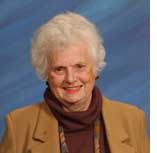 LA JOLLA, California--What is it that causes people’s need to help and come to the rescue of others who are experiencing a crisis? This phenomenon occurs whether one is witnessing an accident and stops to help or reads about an earthquake far away and sends money or blankets. LA JOLLA, California--What is it that causes people’s need to help and come to the rescue of others who are experiencing a crisis? This phenomenon occurs whether one is witnessing an accident and stops to help or reads about an earthquake far away and sends money or blankets.
To wit, the outpouring of food and clothing to Qualcomm Stadium where so many evacuees were housed during our terrible fires, so much was brought that people were asked to stop the donations.
Natasha Josefowitz
This is helping strangers, people you have never met and who won’t know who to attribute this largesse to.
A similar event occurred here in La Jolla when a busload of people had to be turned away from Qualcomm because they were too ill and the driver was calling facilities desperate to find shelter. Due to current construction, the retirement community of the White Sands of La Jolla had some apartments available. They took ten people into their skilled nursing facility and then brought four to the Cloisters of La Jolla, a skilled nursing facility, as these people were in need of more medical help than could be provided. They were accepted there too, free of charge. County Health contacted White Sands and asked them to take in more evacuees— eighteen were housed from one to three days, also` at no charge.
White Sands had to use extra staff and spent $4–5,000 for renting beds, buying linens, towels, and sundry toiletries such as toothbrushes, toothpaste, shampoos, and hand creams. One room was converted into a hospitality center where food was provided as well as a TV to watch the fire as it unfolded.
Six residents offered their extra rooms; there was an outpouring of clothes, blankets, and kitchenware. Residents even donated some jewelry. I’m quoting a card that was received from one of the evacuees: “Not knowing who gave the necklace to my daughter (age 13), please make sure the person knows that it has been the first thing that she has received that she has actually called hers. And now that she has finally grabbed onto one material thing, I think she can finally start to walk out of the ash that has been her recent past. Thank you.” Another letter writer says that the response from residents and staff has restored her faith in human kindness. Today there are boxes piling up with Christmas decorations to give to those who lost theirs in the fire.
Most of the older folks here in White Sands have been major players in industry, education, the military, they have been at the top of their professions, and now instead of “has beens” they have morphed into something new: a caring community, a family of people who look out for not only for each other but for outsiders as well
So what is all this about? Is altruism in our genes? Is it a survival mechanism—“I take care of you so that you will take care of me?” We still have the genes from a time when the welfare of our tribe was essential to our own survival. Recent studies have shown that my own brain will light up in the same area as the brain of a person in pain when I witness that hurt. In other words, we do feel others’ pain and this might explain the wish to make things easier for those who have lost everything, who are fearful, who have nowhere to stay.
So we are back to our ancestral beginnings eons ago, a tribe, here for each other, feeling good about being able to help.
We are still here for each other and yes, it feels good to be able to help.

SAN DIEGO JEWISH WORLD THE WEEK IN REVIEW
FRIDAY-SATURDAY, DECEMBER 14-15
Garry Fabian in Melbourne, Australia: Marko Perkovic and pro-Nazi band to tour ... Mazel Tov: Olmert congratulates Rudd ... Downer: Champion of the Jews .... Disurbing ECAJ report
Donald H. Harrison in San Diego: Men in grocery stores: a step to peace?
with companion article: Spira enjoyed a varied food industry career
Rabbi Leonard Rosenthal in New York City: Museum examines Jewish origins of ‘Shrek’
THURSDAY, DECEMBER 13
Judy Lash Balint in Jerusalem: Haredim brighten nights with Chanukiyo
Peter Garas in Canberra, Australia: An unaffiliated Jew in Australia's capital
Donald H. Harrison in San Diego: School, prompted by constant Hamas rockets, determined to be best in Israel
Dov Burt Levy in Salem, Massachusetts: Should we teach the Holocaust to children?
Gert Thaler in San Diego: Gert looks over her first 87 years as a member of San Diego's Jewish community
WEDNESDAY, DECEMBER 12
Norman Greene in San Diego: Tel Aviv unblocked this San Diego writer
Donald H. Harrison in San Diego: Exhibit to preview possible creation of a School of the Arts within SDJA next year
Ira Sharkansky in Jerusalem: Do Jews have a gene for excess conscience?
Dorothea Shefer-Vanson in Mevasseret Zion, Israel: Reactions mixed to Israel's rainy winters
TUESDAY, DECEMBER 11
Donald H. Harrison in San Diego: Former 'Little' Pal now a mentor himself.
Larry Zeiger in La Jolla, California: Cry Baby: A flashback to the 1950's.
MONDAY, DECEMBER 10
Donald H. Harrison in San Diego: Synagogue bids farewell to a woman who shunned the honors that inundated her
Sheila Orysiek in San Diego: City Ballet's Nutcracker sparkles
< BACK TO TOP
|
|

